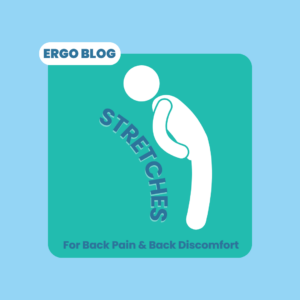Updated: Apr 27, 2023
How to Improve Ergonomics in a Sewing Room
Have you ever felt pain while sewing? Has your neck felt uncomfortable from looking down at your sewing machine for too long? If so, you’re not alone. Luckily, there are some simple ways to reduce the strain on your body by improving ergonomics in your workspace.
1. Task Lighting
The first step to creating an ergonomic sewing room is to make sure that you have adequate task lighting. Task lighting is the type of light that you use for close-up tasks like sewing, embroidery, or hand knitting–not ambient lighting for general room illumination. While ambient (general) lighting can be helpful in making your workspace feel cozy and inviting, it often makes it difficult to see small details in your project.
- Make sure the task lights are bright enough but not too bright. A bright light should also have a shade on it so you cannot see the light bulb. The goal is to only see the light shining onto your work area.
- Position the light directly above your workstation so that there isn’t any shadowing caused by the glare off surfaces such as glass tables or mirrors nearby. You also don’t want shadows cast onto fabric either because they will distort what you’re looking at, making it harder for your eyes to interpret the needed details.
2. Height Adjustable Workstations
The next step to is to assess the areas within your workspace that need to be raised or lowered. This will allow for proper posture and alleviate stress on your body. A more adjustable piece of equipment can lead to a better fit for you. Office chairs, sewing machine tables, ironing boards, and lights are some of the equipment items that can be adjusted to better fit you and your needs.
- Office chair. Purchasing an office chair with good back support can help keep your body in an upright and neutral position. It will also allow you to get the support you need by having the height of the chair at the best location. Depending on the given sewing task, armrests may be helpful. Other times, armrests can get in the way with frequent movements. The ideal position for your chair should allow your knees, hips, and elbows to all be at 90 – 100 degrees of flexion when seated. When leaning forward to complete tasks such as using a sewing machine, consider using a chair with a forward tilt seat pan so you can maintain hip flexion of 90-100 degrees. Refer to this blog for positioning recommendations when using an office chair.
- Sewing machine tables. These are great options to get your sewing machine to the height you need. You can adjust the height of your sewing machine so that it’s at a comfortable level for you to use and help prevent repetitive stress injuries in your hands and wrists. Adjust the height of your sewing machine so your elbows are at 90 – 100 degrees of flexion with your arms in your comfort zone while you are working. Your comfort zone is a position where your elbows are by your sides and at 90-100 degrees of flexion without outstretched arms. Most comfort zones are at waist level.
- Adjustable height sewing machine tables will also increase in height so you can stand for part of your day. Standing in one spot can be a challenge so be sure to avoid standing for a long duration. A great schedule would be standing for 5-15 minutes every hour and then sitting for the remaining time. Also include stretches within the hour.
- Ironing board (and light). An ironing board is an important piece of equipment that should be set up at a comfortable height so that you won’t have to bend over while using it. Place the ironing board at a level where you can iron with your upper extremities in your comfort zone.
3. Magnifying Glass
A magnifying glass is a must-have tool for anyone who works with tiny items. It can be used for sewing, embroidery, quilting, and other crafts as well as reading instructions or small print. When our eyes cannot see items clearly or they must strain to focus, the natural response is to change our posture to improve our visual focus which can result in an improper position. Use a magnifying glass to enlarge your project so you can maintain a good posture. Also, consider using a magnifying glass with light as an additional benefit.
4. Sewing Machine Tilt
A sewing machine that is tilted can help improve your line of sight. A standard sewing machine is set so it is parallel to the floor. When the sewing machine is set where it is parallel to the floor, we cannot always clearly see the area where we are working. We then tend to lean forward and crouch down to get a better view of our work area which is not a great posture. To counter this, you can tilt your sewing machine back slightly (a few degrees), which will have a positive effect on your body and allow you to have more of an upright posture. Using a tilted sewing machine platform will help to improve positioning. A more cost-effective solution would include going to the hardware store and purchasing shims. These can be stacked and glued together to create a lift on one side of your sewing machine. Be sure to attach a non-slip surface to the top of the final shim. On the opposite side of your sewing machine, you can place a shelf liner or Dycem so your sewing machine does not slide.
5. Job Task Rotation
Job task rotation is regularly transitioning between different job tasks to avoid being in a prolonged posture. When possible, vary the job tasks that are done throughout the day to various positions. Avoid doing one task for several hours at a time. Ideally, you would want to frequently rotate job tasks, such as using a sewing machine, ironing, hand stitching, and other items. Aim for rotating job tasks at least once per hour. Once you are used to this routine and want to kick it up a notch, aim for rotating job tasks once every 30 minutes.
We hope that this article has helped you understand the importance of ergonomics in your sewing room. It’s not just about being comfortable and safe, but also about improving your productivity and efficiency so that you can get more done in less time. We’ve covered many different aspects of sewing machine design here today–from lighting levels to chair height adjustments and even job rotations. If any of these ideas sound like they could benefit your own workspace, then go ahead and give them a try!
Check out our YouTube video below for a visual representation of the blog!
Apr 22, 2024
Apr 15, 2024
Apr 9, 2024



